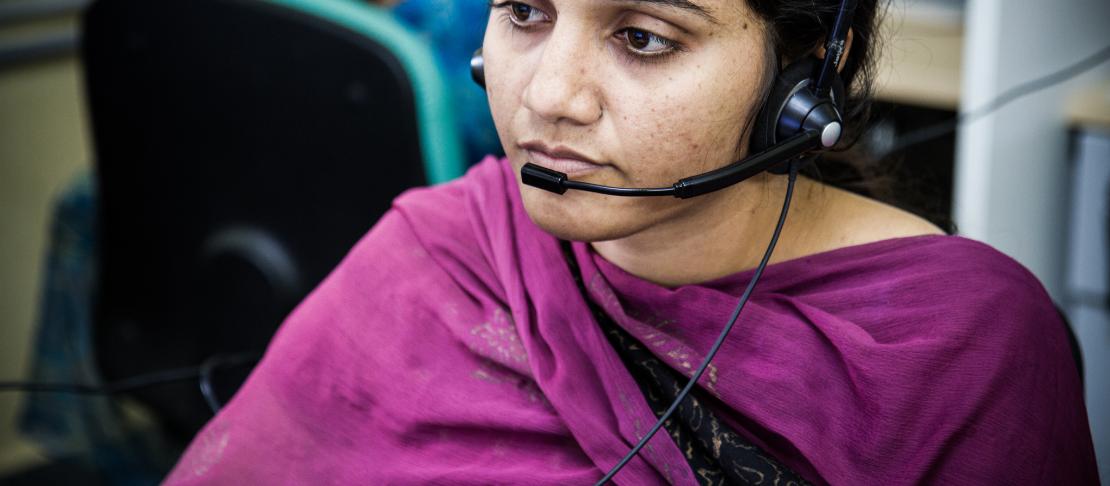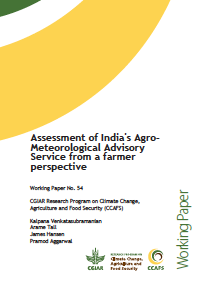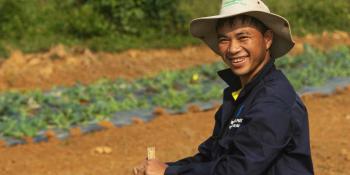Diverse and inclusive communication leads to better uptake of agro-met services: study

Study finds a wide range of communication channels are key to meeting diverse communications needs in climate services as women, in some cases, have different communications needs than men, and less accessibility to services.
Two years ago, the advisory recommended delaying harvesting of wheat crop based on heavy rainfall forecast. I did so and saved my crop. If I had harvested, then heavy rains would have destroyed the harvested grains left in the field.”
–male farmer from Amtrar, Himachal Pradesh
The Indian monsoon is a lifeline for millions of farmers across the country, who depend on the quality of the rains for their livelihood. A weak or irregular monsoon can devastate crops and wreak havoc on the economy. Dry spells during the growing season can damage crop growth; floods may drown crops in the fields, or ruin a fresh harvest.
In a warming world, weather and climate extremes are becoming more frequent and more intense, and advisories on extreme weather are more relevant than ever.
The Government of India has long recognized the need to give farmers a hand in anticipating the rains and understanding what they mean for their crops. Through India Meteorology Department (IMD)’s national Agro-meteorological Advisory Service (AAS) program, farmers across the country have been receiving weather-based, crop-focused agro-meteorological advisories since 1981.
The advisories are based on a five-day short-range weather forecast produced by the IMD, and provide actionable advice on the timing of planting and irrigation, what pesticides and fertilizer to use and when, as well as other relevant information and support. The program reaches millions of farmers through innovative communications tools such as SMS, interactive voice response, and farmer call centers.

VILLAGERS IN GORITA, ANDHRA PRADESH RECORD RAINFALL AS WELL AS WHAT THE FORECASTS PREDICTED. PHOTO: F. FIONDELLA (IRI).
To understand the sources of its success, the CGIAR Research Program on Climate Change, Agriculture and Food Security, working together with the International Crops Research Institute for the Semi-Arid Tropics (ICRISAT) and IMD, conducted a village level assessment of the AAS program. A new working paper detailing the assessment offers lessons that can guide investment in climate and agro-meteorological advisory services for farmers elsewhere in the world.
Researchers talked with 490 male and female farmers in eighteen villages across six states about how they receive and use AAS advisories, gaps in services, and suggestions for improvement. Farmers had a lot to say:
“Three years ago, I found out from a weekly advisory that rain was forecast and transplantation of paddy was recommended. I followed the advice and reaped a good crop. Farmers who did not follow the recommendation delayed transplantation by 15-20 days and had lesser yields.”
– male farmer from Amtrar, Himachal Pradesh
WATCH: Video from several of the villages selected for interviews features in the mini-documentary Voices from the Fields: Benefits and Potential of Climate Information for Smallholder Farmers in Mali and India, including farmer interviews:
Voices from the Fields from IRI on Vimeo.
The assessment underscores the challenge of meeting the diverse needs of farmers.
In some cases, women and men preferred different types of communications channels for agro-climate advisories. In Himachal Pradesh, male farmers identified radio and television as good channels to reach them. But women farmers have limited access to radio or television during the day due to engagement with other household and field related activities.
Farmers noted that trainings and discussions with agricultural extension officers at the village level were their preferred form of receiving information, but ensuring wide representation in discussions is a challenge. For example, in West Bengal, women farmers noted that experts came for discussions in the villages sometimes, but those were limited to male farmers only.
On the other hand, in villages where women were fully engaged in receiving and disseminating AAS information, use and benefit from the program was maximized.
Women overall had lower awareness of AAS than men do, indicating the importance of targeting women in communications efforts. The establishment of specific trainings and discussions on AAS for women farmers in the villages was recommended by farmers, as were trainings and interactions with scientists that all farmers can attend.
Membership in women’s or farmers groups may help increase awareness of AAS information, and extension services targeting existing local groups could be a strategy for increasing the effectiveness of communication of AAS information. In one village in Tamil Nadu, a female farmer volunteered to record weather data from the weather station in her village. Due to her interaction with other women farmers in the village, there was a great deal of enthusiasm among local women farmers about AAS information and further improvements on it.
Differences in the wealth and social status of farmers spell out additional challenges to advisory services. In Punjab, richer “progressive” farmers received AAS information regularly and were able to benefit from it. They had better access to information due to their connections with advisory units or extension officers and resources such as Internet access. In some cases they helped organize trainings in the village to disseminate information to others farmers, but this wasn’t always the case.
The assessment highlighted the value of diverse communications approaches. In states where many communications channels were used, such as SMS and voice messaging, meetings and trainings with agricultural extension officers, local knowledge centers, radio, farmers’ clubs, and announcements over the microphone in villages, awareness and use of AAS advisories was higher, including among women.
Farmers also talked with researchers about their recommendations for improving the program. They advocated for a larger farmer role in communication of advisory information through the appointment of village level volunteers who could receive bi-weekly advisories from extension units and communicate them to the rest of the village, increasing ownership in the program.
In addition, farmers asked for an increase in the reach of advisories provided by voice mail and SMS, as not all villages are receiving these yet. Less technical language in the advisories, and the use of pictures of things like pests to make advisories more comprehendible were also requested.
Learn more about climate risk management approaches in India:
READ: Improved rainfall indices help insure more than 50,000 farmers in India
READ: Better rainfall data means Indian farmers have better insurance against crop failure
READ: Empowering women to manage climate risks in Nepal and India
READ: How useful is climate information to smallholder farmers in India?
READ: Project tests new ways to deliver climate messages to farmers' cell phones
This blog story was written by Dharini Parthasarathy, a Communications Specialist at CCAFS South Asia and Alexa Jay, Program and Communications Officer - CCAFS theme on Climate Risk Management.




